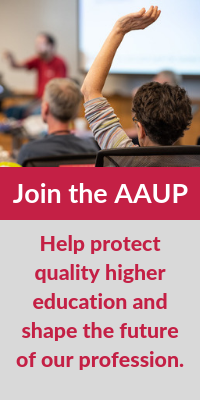- About
- Programs
- Issues
- Academic Freedom
- Political Attacks on Higher Education
- Resources on Collective Bargaining
- Shared Governance
- Campus Protests
- Faculty Compensation
- Racial Justice
- Diversity in Higher Ed
- Financial Crisis
- Privatization and OPMs
- Contingent Faculty Positions
- Tenure
- Workplace Issues
- Gender and Sexuality in Higher Ed
- Targeted Harassment
- Intellectual Property & Copyright
- Civility
- The Family and Medical Leave Act
- Pregnancy in the Academy
- Publications
- Data
- News
- Membership
- Chapters
A Master Class in Organizing
 The Union Member's Complete Guide, 2nd ed. by Michael Mauer. Brooklyn, NY: Hard Ball Press, 2019.
The Union Member's Complete Guide, 2nd ed. by Michael Mauer. Brooklyn, NY: Hard Ball Press, 2019.
Academic unions are not new, but many of their members are new to unionism when they join faculties represented by collective bargaining. At many colleges and universities (including mine), instructional staff with a variety of appointment types are more likely to have the option to join existing unions than ever before. Tenured and tenure-line faculty, part-time instructors, term lecturers, and graduate teaching assistants are already unionized on many campuses. Now, new and renewed organizing efforts are emerging across the country as a result of threats to the future of our profession posed by the COVID-19 pandemic and by administrative responses (and, in some cases, overreaction) to it, while Black Lives Matter protests have revitalized public activism.
Enter this revised and updated edition of The Union Member’s Complete Guide, essential reading for every union leader, activist, organizer, and steward at any moment but especially this one. The Guide is a clear, engaging read that doesn’t miss a detail and deftly avoids insider arcana and legalese. Author Michael Mauer, a longtime labor attorney, activist, and educator as well as a former AAUP staff member, finds that elusive sweet spot between thoroughness and accessibility, making the second edition an invaluable field guide to life on your union campus or in any other union job. While the intended audience for the book is not solely academic, faculty members engaged in union work will find much information here that they can put to immediate use.
Beginning with an introduction that imagines a diverse readership—union members and leaders who have “inherited” an existing collective bargaining unit organized by their predecessors, people who are not union members now but are interested in organizing their workplace, members of new unions after successful campaigns, students in labor studies and human resources programs, and even people employed in management roles—Mauer organizes the body of the Guide into twelve short but substantive chapters.
While this introductory guide assumes little or no previous knowledge or experience, there is a lot here to learn even for experienced union activists. Chapter 1, “What Are Unions?,” starts with the basics by covering the major structural and experiential differences between union and nonunion workplaces. Mauer opens with the fundamental premise of unionism, that “one person standing alone will be weak, but many joined together are powerful,” and develops this simple tenet in brief but compelling statements. For example, he notes that “the union has the right—and the legal obligation—to speak with one voice” on behalf of its members and explains that “this means that the employer loses the power advantage of dealing only with individuals, one-on-one.” Of the tensions that can arise when collective action requires giving up “a certain amount of individual control,” he reminds us that “in a non-union workplace the employer makes all the rules.”
Next, “How Your Union Operates” is a useful primer on union governance structures, explaining chapter organization and the relationships between chapters and their national parent organizations. There is also a helpful description of stewardship structures and the roles that stewards fill in union governance, although some academic readers might find this general account difficult to map onto the structures of their own unions.
Other chapters include “The Union’s Responsibility to Its Members,” “Your Union Contract: What It Covers,” “Where Do Workplace Rights Come From?,” “Your Role in Your Union,” and “If You Get In Trouble,” all with essential information presented in clear, concise language and illustrated with occasional sidebars and vignettes about important figures in labor history, landmark court cases, and significant organizing campaign successes.
The chapter “A Member’s Rights and Responsibilities” addresses dues structures and dues payment, payroll deduction, and how to help colleagues understand why they should be dues payers. The material here is especially relevant in light of the 2018 US Supreme Court decision in Janus v. AFSCME, which ruled against “fair share” dues-payment requirements for nonmembers represented by public-sector unions while still obligating unions to provide benefits to nonpayers. Mauer explains the case in a paragraph contextualized by the chapter’s more expansive discussion of “right-to-work” ideology and law. The chapter includes a short but compelling vignette on the unsavory history of this antiworker ideology, tracing early use of the term right to work to a well-funded organization that engaged in racist and anti-Semitic rhetoric in its campaigns against collective bargaining and whose leader, Vance Muse, had also actively opposed child labor laws and women’s suffrage.
The chapter “Your Union Contract: Getting There” is a standout, characteristically succinct but with a mother lode of wisdom and actionable advice for negotiating a collective bargaining agreement. It covers the process of surveying and educating members, recruitment of the bargaining team, laws governing subjects of bargaining and the bargaining process itself, what to do if things go wrong at the bargaining table, and the importance of contract campaigns. On this last topic, Mauer maintains that “the real power [is] away from the table” and that negotiations are won and lost on the basis of “how much each side can successfully exert pressure on the other if agreement is not reached.” Since labor negotiations are necessarily an exercise in asymmetry—as my chapter’s longtime president and legendary negotiator Lynwood Bartley used to say, “What does the administration bring to the table? The table!”—the best leverage of any union is the strength of its numbers. Mauer writes,
If an employer gets the message that the small group of union negotiators it’s dealing with face to face is in fact speaking for large numbers of bargaining unit members, that creates pressure for the employer to give the union what it wants. Most important, the employer must come to believe that if issues aren’t successfully resolved at the table, the members won’t take the employer’s “no” for an answer. . . . Having a bargaining team consisting of folks with the needed expertise is necessary, but not sufficient, to win a solid contract. Actions outside of the bargaining room are almost always essential to get what’s needed inside that room.
Two chapters on contract enforcement, “Grievances: Enforcing Workplace Law” and “Arbitration: The End of the Line,” address the expected subjects of what can and cannot be grieved, individual versus union or chapter grievances, the customary steps in grievance and arbitration procedures, and key factors to consider in deciding whether to take a case to arbitration, including its “organizing potential.” These chapters also include a variety of less obvious reasons to consider filing grievances, even in some cases for minor issues and often in cases you think (or you know) you can’t win: to bring attention to problems, establish a record of documentation when you have reason to anticipate a more substantial violation down the road, “fire a warning shot” that certain management behaviors are not going to be tolerated, and build solidarity around an issue important to your members. (Mauer notes, though, that “a direct, quick, ‘in-your-face’ demonstration of the employees’ will” may be a better option than a grievance in certain circumstances.)
The chapter “The Union’s Face Outside the Workplace” strikes me as particularly timely. It focuses on organizing a new union, building strength and solidarity in an existing bargaining unit, and the role of unions in political organizing, in which unions and their members help to elect worker-friendly candidates and advocate for legislation that supports working people. Mauer notes the resistance of some union members to political organizing but points out that “the priorities that are set by our elected leaders determine in large part what resources will be available to us as organized workers.” This may be especially relevant to those working in public colleges and universities, where defunding by state legislatures has been underway for decades. Now, with the COVID-19 pandemic, the situation is more immediate and more dire. What will our public universities look like when it’s over? How many will still be fully operational? Our jobs depend on the answers. And the answers depend on the people we elect to public office. Mauer asks, “If you’re not convinced your union should be involved in politics, the question is, if unions don’t lobby for workplace health and safety laws, or for living wages, then who will?” To this I would add: If we don’t lobby for robust public funding of higher education, who will?
The Union Member’s Complete Guide delivers exactly what its cover promises: “everything you need to know about working union.” I wish every current and aspiring union officer and steward on my campus would read this book and take it to heart. In my ideal world, all our members would do the same. It is hard to imagine anyone better suited to author a book like this one than Michael Mauer, who has been active in union work for more than forty years, first as a lawyer with the National Labor Relations Board and later in a variety of educational positions as well as in roles with the Service Employees International Union and the AAUP. While this is an introductory text, and some of the content may therefore seem elementary to seasoned union organizers, activists, and leaders, there is still plenty of useful knowledge for them here. As a longtime labor activist and long-serving AAUP collective bargaining chapter leader at a public university, I found much in the Guide that I will use going forward. Mauer’s extensive experience in the labor trenches, combined with his gifts as an educator and writer, offers an invaluable perspective in clear, accessible prose.
Lisa C. Minnick is associate professor of English linguistics at Western Michigan University and president emerita of the WMU-AAUP. She has served on the AAUP national Council and its Executive Committee. Her email address is [email protected].



